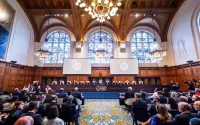Common Dreams / Published on Thursday, November 1, 2007 by TomDispatch.comMike Davis
This August, just as the first Santa Ana winds bent the boughs of the eucalyptus trees in Balboa Park, 500 wealthy business people and Republican Party donors raised their champagne glasses to salute “Mr. San Diego,” Pete Wilson, as he unveiled a bronze statue of himself in downtown’s Horton Plaza. Wilson, of course, was the controversial, immigrant-baiting governor of California during the nineties; but the statute specifically apotheosizes his role as the political catalyst for San Diego’s “downtown renaissance” during his earlier three terms as mayor of the city (1971-1983).
The 74-year-old Wilson, whose preppy appearance leads strangers to mistake him for an aging member of the Kingston Trio, recalled the bad old days — before million-dollar condos and billionaire developers took over downtown — when the nearby “Gaslight District” was a “haven for saloons and tattoo parlors.” He praised the memory of his friend and crucial ally in remaking downtown, developer Ernest Hahn, whose statue adjoins his. But it was difficult to make out his words since, across the plaza, several hundred demonstrators, an inspiring coalition of young Latinos and gays, were beating drums, blowing whistles, and chanting “racist!” Some of Wilson’s admirers blistered, but Mr. San Diego was characteristically gracious about free speech: “Horses asses,” he laughed.
He was cheered by a small group of counter-protestors belonging to one of the Minutemen sects. Although far too scruffy to be invited to join the champagne drinkers, they nonetheless idolize the former governor as the Paul Revere of the Brown Peril (especially for his notorious television reelection ad: “They keep coming…”), as well as the chief megaphone for the passage of Proposition 187 in 1994 which — had it not been stopped in the courts — would have expelled immigrant kids from their kindergartens and kicked their mothers out of maternity wards.
It is unclear, however, whether either the immigrant-rights activists or their Minutemen opponents were aware that what they were protesting or applauding was actually self-deification. As the San Diego Union-Tribune (the Copley franchise that has had a total monopoly of the city’s daily newspaper market since 1938) reported the next day: “The land under the Wilson and Horton statues is owned by the Irvine Co., the Orange County real estate giant that bought the property recently. Wilson is a member of the company’s board of directors.”
Most of my friends dream of the day when we can give that statue the same shove that brought down the Colonne de Vendôme in Paris in 1871 or Saddam Hussein’s statue in Firdos Square in Baghdad in 2003, but I demur. I think we should simply chisel the word “arsonist” in large letters at the base of the Bronze Pete.
No, I am not suggesting that the ex-governor was seen lurking in the shadow of Palomar or hiding behind an oak at Witch Creek as the fires began to burn — although who knows what he does with his time when he isn’t recruiting for Rudy Giuliani? But, as the protestors rightly won’t let the world forget, he deliberately ignited California’s nativist underbrush in the early 1990s and started a conflagration of immigrants’ rights that now engulfs Latino communities across the United States.
With unctuous arrogance, he mainstreamed Mexican-bashing and opened a Pandora ’s Box of California’s vigilante past. The Minutemen are one bastard legacy of his; another is public gullibility in the face of absurd rumors and bogus “CNN” press releases (”Mexicans with Molotov cocktails” and the like) that are currently being blogged back and forth across dirty cyberspace. And we should not forget that Wilson was personal trainer, sage, and guru to Schwarzenegger in those early days of 2003 and 2004 when Arnie was praising the Minutemen as “heroes.” (The Gubernator, of course, has since been reprogrammed to the political center by Maria Shriver and her technicians.)
But the Wilson legacy also includes an important, if more complex, responsibility for the pattern of urban growth in the San Diego region that now collides so catastrophically with wildfire. As a so-called liberal Republican, even “green” San Diego mayor during the 1970s and early 1980s, he was the chief architect of an enduring system of trade-offs, elite alliances, and sleights of hand that has simultaneously gentrified the downtown area at the expense of the poor and overrun much of San Diego’s countryside with pyrophiliac gated suburbs and elite estates — all the while winning accolades for state-of-the-art “growth management.”
In the wake of the auto-da-fé of the city’s old guard in the early 1970s (including the arrest and conviction of its two most powerful business figures), Wilson — initially allied with wealthy Democrats — skillfully overhauled a geriatric City Hall and soothed the alienation of angry neighborhood homeowners. He slowed piecemeal growth at the urban periphery, which impressed the Sierra Club and environmental voters, although the real logic behind these moves was to transfer control over metropolitan growth from smaller developers to giant companies with the financial resources to undertake the phased construction of upscale suburbs and edge cities.
Wilson’s 1976 masterstroke, however, was to horse-trade development rights along the city’s northern flanks for new investment in the downtown’s faltering redevelopment scheme. Thus, he bartered the beautiful mesas across Interstate 5 from the University of California, San Diego, to (fellow statue) Ernest Hahn (who promptly constructed “University City”) in exchange for the latter’s agreement to redevelop Horton Plaza downtown. A similar quid pro quo was negotiated for the development of an adjacent “protected” open space as the Pardee Company’s “North City West.”
These were not just a set of ad hoc deals but a consistent template for an unmatched fusion of real estate and politics. The typical American big-city pattern is chronic competition and political friction between downtown interests and edge developers; in San Diego, by contrast, Wilson brought the suburban builders downtown and so created a unitary and powerful growth machine which, in turn, has greased his wheels and those of his many protégés and successors. (Indeed, Wilson’s reputation as the “strongest mayor in San Diego history” is attested by the continued zeal with which all white, male Republicans, including the present mayor and his predecessor, profess loyalty to his achievements.)
This hypertrophying of developer power, which Wilson institutionalized and willed to future generations, has easily survived small popular insurrections against the impact of sprawl and congestion, just as it has surmounted unremitting scandal and corruption in local politics. Pete Wilson’s successors have specialized in giving away one priceless city asset after another — the former Naval Training Center, the Broadway pier, the Fairbanks Ranch, Petco Park, among many others) to the same small elite of billionaires. They are even discussing privatizing the management of San Diego’s incomparable Balboa Park.
The imbalance of power is greater yet at the county scale. In the wake of the last round of firestorms in 2003, a grassroots alliance of environmentalists and old-time rural residents tried to slow the subdivision and trophy-home juggernaut by limiting residential density to one home per 100 acres: an initiative inspired by the famous precedent of Oregon’s Willamette Valley. They were, however, utterly crushed at the polls (65% to 35%) by a flood of developer money, which disguised itself in ads on television as the voice of embattled “small farmers.”
More recently, on the very eve of the new firestorms, county supervisors endorsed a so-called “shelter in place” strategy that will permit developers to build in the rugged, high-fire-risk backcountry without having to provide the secondary roads needed to ensure safe evacuation. Instead residents would be encouraged to stay in their “fire resistant” homes while fire-fighters defended the perimeter of their cul-de-sac. As scores of fire experts and survivors have pointed out in angry op-ed columns and blogs, this is a lunatic, if not homicidal, scheme that elevates developers’ bottom-lines over human life. Those who have actually confronted 100-foot-high firestorms, driven by hurricane-velocity winds, know that the developer slogan — “It’s not where you build, but how you build” — is a deadly deception.
Meanwhile, the new fire cataclysm seems to be rewarding the very insiders most responsible for the uncontrolled building and underfunded fire protection that helped give the Santa Ana winds their real tinder. While conservative ideologues now celebrate San Diego’s most recent tragedy as a “triumph” of middle-class values and suburban solidarity, the business community openly gloats over the coming reconstruction boom and the revival of a building industry badly shaken by the mortgage crisis. And the Union-Tribune — like London papers after the slaughter that was the battle of the Somme in 1915 — eulogizes the very generalship (all Republicans, of course) that led us into disaster. I suppose these heroes already envision their statues in Horton Plaza.
Mike Davis, who teaches urban history at U.C. Irvine, grew up in the now incinerated backcountry of San Diego County. His other articles about the recent Southern California fires will soon be published in the Nation and the London Review of Books. His most recent book is In Praise of Barbarians: Essays Against Empire (Haymarket 2007).






